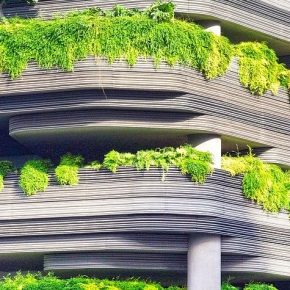
GUEST ARTICLE: Sustainable Power – How the logistics sector is turning green
 Historically, warehouses have had bad press; often seen as dark, dingy and unpleasant places to work. But the logistics sector has been changing for a while now, with state-of-the-art new builds, a plethora of green initiatives and retrofitting projects designed to improve energy efficiency. Jason Rockett, managing director at Potter Space, has more…
Historically, warehouses have had bad press; often seen as dark, dingy and unpleasant places to work. But the logistics sector has been changing for a while now, with state-of-the-art new builds, a plethora of green initiatives and retrofitting projects designed to improve energy efficiency. Jason Rockett, managing director at Potter Space, has more…
Whilst this has been most visible in the big box arena, it is now a firm feature of the small to mid-box segment of the warehousing market. However, for some in this market segment, while going green is high on the agenda, the costs can be prohibitive and the intricacies of the Government’s target of net zero by 2050 could mean that they are unsure of where to start. So, what can small to mid-box property companies do to ensure a future that will see greener industrial and business parks across the UK?
There are two routes to upgrading an estate’s green fundamentals through the warehouse units themselves: by building new warehouses or retrofitting existing ones. Whilst there are benefits for both, there can also be pitfalls. For example, refurbishing older units is significantly less carbon intensive than a new build, however, developers may find older structures are unable to support new technologies such as solar installations (PVs) due to load considerations.
Equally, building a new unit is costly, with long payback times and the requirement of a significant amount of land to develop. For businesses that are weighing up the different options, an audit of the units should be conducted to see whether refurbishment is a viable route, or whether it is better in the long term to begin a rebuilding programme.
The technology available to support sustainable development is improving year on year, but is still relatively new within the industrial and logistics sector, particularly to the small to mid-box segment. As industrial estates and business parks seek to evolve their ESG features, comprehensive research will be key to matching specific technology to the specific needs of both the property company and its customers.
It is crucial for property companies to take the time to learn about their own unit stock, research what other developers are doing to improve their green credentials and talk to the manufacturers of green technologies to see how they can improve their units.
Biodiversity net gain approach
However, achieving green goals isn’t limited to installing greener sources of power or LED lighting, it also comprises the land on which the park sits. The Government’s transformative biodiversity net gain approach to land management encourages businesses to appropriately utilise the land whilst minimising the negative effects that development activity can have on the environment. Whilst this is no small endeavour, investing in the environment around a park does much more than enhance green credentials.
By seeking to bring nature back to the site through initiatives such as planting wildflower seeds to support wildlife populations or even creating a nature reserve from a balancing lake, businesses will additionally create better environments for their staff and customers to work in. Installing a nature walk, for example, could boost the mental health of the site staff and customers, as could creating green ‘break-out’ areas for people to sit and enjoy their lunch in.
There is still a way to go for the industrial and logistics sector to have the necessary resources available to utilise sustainable features and technology across their parks, however, small to mid-box providers are increasingly aware of what is expected of them, and the forward-thinking players are going beyond the regulations in creating sustainable environments. There are already a great number of simple changes that can be implemented almost immediately to drive further towards sustainability, but there are still many areas that require joined-up thinking and an in-depth strategy if the targets are to be met and expectations exceeded.
Though 2050 could feel like it is closing in rapidly, with the right advice and by reaching out to those who have started to make sustainable changes, small to mid-box property companies will see that we are all in this together, and with some collaboration and good will, it is entirely possible to achieve the government’s green target of net zero.
Latest news

4th March 2025
S. Norton Group showcases £20m shredder for metals recycling CEOs
S. Norton Group hosted a tour of its latest £20m investment in state-of-the-art shredder technology for 17 senior leaders in the European metals recycling industry.
Posted in Articles, Building Industry News, Building Products & Structures, Building Services, Case Studies, Facility Management & Building Services, Plant, Equipment and Hire, Posts, Site Preparation, Sustainability & Energy Efficiency, Waste Management & Recycling
28th February 2025
Passivent ventilation solutions are top of the class
Passivent has supplied a combination of Hybrid Plus2 Aircool ventilators and Hybrid Plus Airstract roof ventilation terminals for a new London primary school.
Posted in Air Conditioning, Articles, Building Industry News, Building Products & Structures, Building Services, Case Studies, Ceilings, Facility Management & Building Services, Heating, Ventilation and Air Conditioning - HVAC, Restoration & Refurbishment, Retrofit & Renovation, Roofs, Sustainability & Energy Efficiency, Ventilation, Walls
28th February 2025
Troldtekt: New acoustic liner ensures good acoustics and easy handling
Both a building’s users and its developers have a good reason to get excited about the new Troldtekt Plus 25 panels. This specially developed acoustic panel sets a high standard for both sound absorption and building efficiency.
Posted in Acoustics, Noise & Vibration Control, Articles, Building Industry News, Building Products & Structures, Building Services, Building Systems, Ceilings, Facility Management & Building Services, Floors, Innovations & New Products, Insulation, Interior Design & Construction, Interiors, Restoration & Refurbishment, Retrofit & Renovation, Timber Buildings and Timber Products, Walls
28th February 2025
InstallerSHOW 2025 – Registration is now OPEN!
Building on the success of last year, InstallerSHOW is returning to the NEC from the 24th to the 26th of June…
Posted in Articles, Building Industry Events, Building Industry News, Building Products & Structures, Building Services, Exhibitions and Conferences, Health & Safety, Retrofit & Renovation, Seminars, Sustainability & Energy Efficiency
 Sign up:
Sign up: